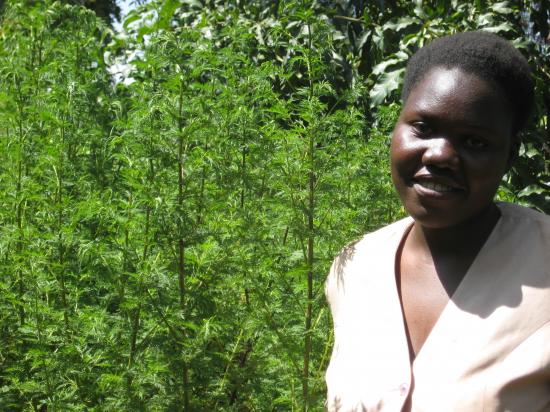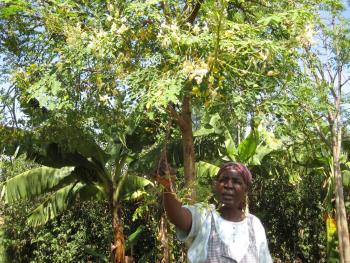Few areas of the world live up to this year's International Women's Day theme to "Make it Happen" as well as the isolated villages of eastern Africa -- where most women grow, process and cook food, often as the sole head of the family.
This may surprise people who think of the women's rights movement as an urban trend based in the more affluent and liberal Global North. But the fact is that rural African women, who shoulder most of the work in all stages of a food system -- seed selection, farming, processing, selling, meal preparation and composting -- are fashioning a food system based on principles of what's called "agro-ecology."
Agro-ecology is regarded as a "science, practice and movement" supporting socially and environmentally sustainable food production. In terms of practice, it is most identified with rejecting monoculture and heavy machinery, and instead growing a wide variety of foods -- including plants, trees and livestock --with relatively simple hand tools, which require no fossil fuel to operate or great expense to the farmer.
Agro-ecology is not only better suited to empower women than the heavily-mechanized and industrial model of food production, which is standard throughout the Global North. Agro-ecology is also well-suited to both preventing more intensive climate chaos by reducing emissions of global warming gases, as well as adapting to the negative results expected from global warming, such as drought, and hurricane force storms, that most experts predict will define Africa's future weather. African women till the fields to make both empowerment and climate stabilization agendas happen at the same time.
The late Wangari Maathai, from Kenya, is the best-known Eastern African woman to link the objectives of women's rights and environmental protection. In 2004, she received the Nobel Prize for her tree-planting campaigns that advanced peace, democracy and the environment.
Today, her work is carried on by women farmers who practice agro-forestry and agro-ecology, farming methods that make generous use of trees to provide a variety of benefits.
Women lead from grassroots
About 70 per cent of Africa's population, 65 per cent of the workforce, make their living on farms. Women do most of the work of subsistence production, especially on the small farms where 70 per cent of the food Africans eat is produced, on less than 15 per cent of the farmland available -- the rest is controlled by plantations that produce food for export.
Women do most of the heavy lifting in agriculture, especially when it comes to hauling wood and water or carrying goods over country roads to markets. A World Bank study in 2009 estimated that women transport 26 metric tonne-kilometers a year, mostly on their heads while walking, compared to men, who carry less than seven metric-tonne kilometers.
Women do most of the work to produce food for the family, including seed saving, hand-hoeing, planting, weeding, harvesting, marketing and food preparation, says Jennifer Muldoon, a Canadian now living in Toronto who taught tree-planting and grafting for food production at farm co-ops in Uganda and Kenya during the period from 2007 to 2010. She worked with these co-ops on behalf of the Canadian Cooperative Association, Uganda Cooperative Alliance and Swedish-based Vi Agroforestry.
Muldoon worked frequently with women, partly because women were typically responsible for most of the tasks of subsistence agriculture, and partly because some of their husbands had been killed or murdered during the prolonged war between the Ugandan army and Lords Resistance Army rebels. She worked with women on their farms, and also on leadership teams of each co-op.

Innovative methods yield nourishing results
The women farmers grew several kinds of trees for several kinds of reasons. Faidherbia trees, a species of acacia sometimes referred to as fertilizer trees or "fertilizer factories," were grown because they drew down nitrogen from the air, providing free fertilizer to exhausted soils, often on land that had been in the midst of conflict zones only months before Muldoon arrived. Leaves and seeds from this tree also provided food for livestock, while protecting the soil from erosion caused by stiff winds and heavy rains.
She also taught how to graft tasty mangoes onto hardy but less flavorful mango root systems, producing a fruit that could be enjoyed by the family and sold at the farmers market. Women who became skilled at grafting sometimes set up nurseries where they sold grafted mango plants at a good margin. Pine were grown for charcoal and firewood, and eucalyptus were grown for construction timber, either at home or in the marketplace.
Whatever the farmer's reason for growing trees, the atmosphere of the planet wins, because trees store carbon in their roots, trunk and branches and preserve carbon stored in the nearby soil from erosion. As a result, farming can be a human activity that actually reduces global warming emissions to the atmosphere.
At the same time -- a plus that is unique to food production -- trees can protect vegetable and grain crops from the stormy weather likely to become commonplace as global warming scenarios unfold. Trees provide shade for animals and plants and also draw up water from deep below, thereby shielding nearby plants from the scorching sun and parched air during prolonged dry seasons, for example.
By planting trees, agro-ecology and agro-forestry honor the ancient subsistence landholder tradition of producing food, fodder, fuel, fabric and medicine on self-sufficient farms, wherein each plant contributes to a whole greater than the sum of the parts.
Gender equity, human health and sustainable climate inextricably linked
But to modernize this tradition, agro-ecology methods enable women to diversify their food supply for their families, and to empower themselves by selling cash crops and surplus in nearby markets, and gaining their own spending money.
A 2012 manual on gender and climate change, produced by the United Nations Development Program produced a 2012 manual on gender and climate change notes that women made up the majority of community leaders, accounting for 58 per cent of extension workers, 75 per cent of nutrition and health workers, and 71 per cent of executive committee members.
"Women also wanted to learn to run a business," and become financially independent, Muldoon says, and the co-op bank was pleased to lend them start-up money "because women had such a high rate of repaying debts."
Such initiative and leadership are rarely rewarded by laws and practices promoting gender equality. But the results could be dramatic, according to a well-documented publication From the roots up: How agro-ecology can feed Africa, which was released last month by the British charity, Global Justice Now. On-farm output could increase by 20 to 30 per cent, it's estimated, and the number of hungry people could be reduced by as much as 17 per cent. Add in climate protection, and the link between equity, human and environmental health is full of promise.




Comments
Do
Don't